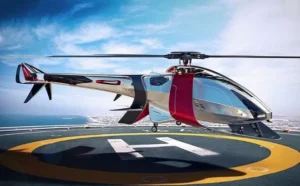Elon Musk, the visionary entrepreneur known for revolutionizing industries with Tesla, SpaceX, and Neuralink, has once again captured the world’s imagination. This time, he’s taking to the skies with a groundbreaking electric vertical takeoff and landing (eVTOL) helicopter. Unveiled in a much-anticipated public announcement, Musk’s latest venture could redefine the future of personal and commercial aviation.
The Vision Behind the eVTOL Helicopter

Musk has long hinted at his interest in aviation, often teasing the idea of an electric aircraft during interviews. His eVTOL project, however, is no mere fantasy. Designed to be quieter, more efficient, and environmentally friendly than traditional helicopters, this innovative aircraft is poised to disrupt the aviation industry.
“The future of mobility isn’t just electric cars or reusable rockets—it’s seamless, sustainable transport across all dimensions,” Musk said during the unveiling event. “With this eVTOL helicopter, we’re taking a significant step toward making that vision a reality.”
Key Features of Musk’s eVTOL Helicopter
Musk’s eVTOL helicopter isn’t just another aircraft—it’s a technological marvel. Here are some of its standout features:

1. Electric-Powered Efficiency
Unlike traditional helicopters that rely on fuel-burning engines, Musk’s eVTOL runs entirely on electric power. Leveraging Tesla’s advanced battery technology, the aircraft boasts a range of up to 250 miles on a single charge, making it ideal for urban commutes and regional travel.
2. Whisper-Quiet Operation
Traditional helicopters are notoriously loud, creating challenges for urban integration. The eVTOL’s innovative rotor design minimizes noise, allowing it to operate in densely populated areas without disrupting communities.
3. Autonomous Capabilities
Equipped with cutting-edge AI and sensor technology, the eVTOL can operate autonomously or with a pilot. This flexibility enhances safety while laying the groundwork for future air-taxi networks.
4. Compact and Sleek Design
Musk’s engineering team has prioritized aesthetics and practicality, designing a compact aircraft that’s both visually stunning and functionally optimized for vertical takeoffs and landings in tight spaces.
The Implications for Aviation and Beyond
The eVTOL helicopter could have profound implications for the future of transportation:
- Urban Air Mobility (UAM): As cities grow denser, the need for efficient, traffic-free transport becomes critical. The eVTOL helicopter could revolutionize urban commuting, reducing congestion on the ground.
- Environmental Impact: Transitioning to electric aviation is a significant step toward reducing the carbon footprint of the aviation industry.
- Economic Opportunities: The emergence of eVTOL technology could spur a wave of innovation, creating new markets for air-taxi services, infrastructure, and maintenance.
Challenges Ahead

Despite its promise, Musk’s eVTOL project faces several hurdles. Regulatory approvals, air traffic management integration, and public acceptance are just a few of the challenges that need to be addressed before the technology can achieve mass adoption. However, if anyone has a track record of overcoming seemingly insurmountable barriers, it’s Elon Musk.
What’s Next?
Musk has announced that test flights for the eVTOL helicopter will begin in early 2025, with a commercial rollout expected by the end of the decade. With SpaceX and Tesla already transforming their respective industries, this new venture promises to be yet another feather in Musk’s cap—and a leap forward for aviation enthusiasts everywhere.
Conclusion: Elon Musk’s foray into eVTOL technology exemplifies his relentless pursuit of innovation. The eVTOL helicopter is more than just a vehicle; it’s a bold statement about the possibilities of sustainable, efficient, and transformative transportation.
The sky isn’t the limit—it’s just the beginning.



